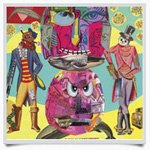Bill Callahan is a complete and utter badass. For my money, the dude released several of the best albums of the '90s and turned in one of the best of the aughts with 2005’s A River Ain’t Too Much to Love. Last fall at one of his final shows as Smog, he presented one of the finest sets I’ve seen in my life. All he had to do was play his music, dance his little jig, and say “thank you” quietly between songs, and I felt like crying. I love this man.
After a set of bordering-on-transcendental tunes on A River, I was completely ready to flip my shit for the new Smog album. I got excited when it was announced, but a little sad when I heard it was going to be released under the name Bill Callahan. Then I saw the cover art. Oh God, no. It’s not the fact that it’s so horrendous, but that it’s so obviously a work by Ms. Joanna Newsom. I think I know a grand total of about three people on the planet who shared my position on Ms. Newsom’s latest offering (that being if I want to listen to a Danny Elfman soundtrack, I’ll go ahead and listen to a Danny Elfman soundtrack) and feared her considerable hand. I was unsettled.
When I finally got my hands on Woke on a Whaleheart and started that first track right on up, I was both relieved and worried. Opener “From the Rivers to the Ocean” certainly doesn’t reek of Newsom, but it is pretty uninteresting. The track stretches to nearly seven minutes of iffy arrangements, questionable lyrics (“Each wave a lunging panther,” “That beautiful thing you said/ Lying in bed/ About all the things I could think of at the end of the day”), and even includes a downright distasteful muffled guitar solo. “Footprints” does a total fake-out, as it jumps from behind a corner with some falsetto, strings, and wailing guitar that quickly drop out for a locked groove of a song, throwing one of Woke on a Whaleheart’s best attributes into full relief: this album is ridiculously rhythmic. “Footprints” is a mostly throb-and-pound kind of track, complete with all kinds of shakers for percussion and gloriously simple strings. It had me looking up.
And looking up I very well should’ve been, because “Diamond Dancer,” rightly the album’s first single, kick-starts one of the best string of songs of Mr. Callahan’s career. The song is one of the most rhythmically pounding and hypnotic works Callahan has ever produced, stunningly simple, with the centrifugal banjo lingering in the background being the only instrumental part I don’t feel confident I could play myself. A screaming one-note guitar acts like that one noise from “Jump Around,” but, like, it’s totally awesome. “Sycamore” was one of the only tracks I’d heard from the album before I got my claws on the entire thing. The fairly stripped live version was stunning, and its studio sibling is just as impressive. The gorgeous guitar part that was the focus of the live version here becomes a centerpiece augmented by God knows how many other guitar lines, a rock steady rhythm, gospel singers, and more strings. Lyrically, Callahan throws in a couple classics: “Sycamore got to grow down to grow up,” and the admittedly kind-of-lost-on-me-but-still-totally-awesome imagery of “There’s sap in the trees if you tap ’em/ There’s blood on the seas if you map ’em.”
“The Wheel” is the most overtly countrified thing here, utilizing the mind-burrowingly effective device of spoken vocal cues before each sung line. The song concerns a demand to the Lord to allow Callahan to make his home, “Lord, in a stable spoke, Lord/ In a turning wheel bound for good.” Hazy laughter and conversation occupy the background of the track, which, like the spoken vocal cues, is initially disconcerting but ultimately allows “The Wheel” to be one of the absolute highlights of Woke on a Whaleheart. “Honeymoon Child” at first seems to end the album’s stellar streak, but the uninteresting, island-conception-concerned first half is quickly remedied as Callahan intones, “You bring out the soft side in everyone,” while gorgeous strings rise on up and meld with slide guitar and tambourine.
Bill and friends “Gather like ravens on a rusty sign/ Just to watch such a little dove fly away” in one of my favorite lines of the entire album. “Day” and “Night” are two piano-based tracks, aptly titled and coupled: “Day” is upbeat and centered on rolling piano lines, light electronics, a hi-hat-heavy rhythm, and “Animals that play,” but still bizarrely retains a vaguely country feel; “Night” is the most low-key track on the album, consisting almost entirely of piano and strings. It’s undeniably pretty, but contains the confounding “We do not know/ The door that holds you/ Silent as glue/ We stand under it/ But we don’t understand it.”
“A Man Needs a Woman or a Man to be a Man” closes things out on a Tennessee Three kind of note. The track is, like so many on the album, pleasant until the strings arrive and push it from pleasant to stunning. The song concerns Mr. Callahan’s uncontrollable urge to light off fireworks during the day, even though he realizes it would be a waste. He sets them off to pass time. Another arrives later with more fireworks and convinces him to wait until night. “When it’s good and dark” they head out and are rewarded with “A golden lion dripping red/ A blue bear spitting white/ A spider fire on a web of sparks/ A green dragon with spiraled eyes.”
More about: Bill Callahan




